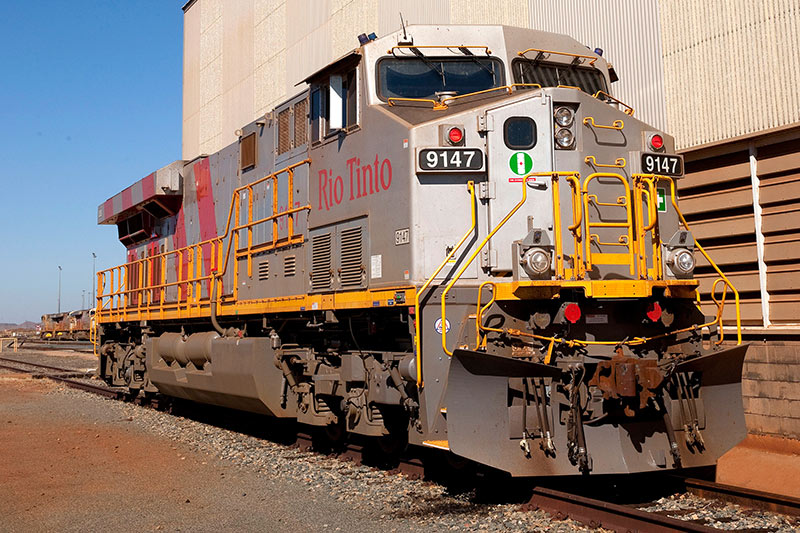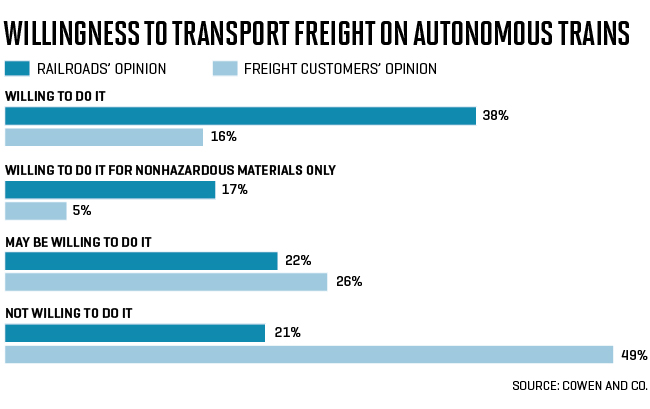無人汽車方興未艾,無人火車又要來了

|
如果一切順利的話,今年8月,一列完全由電腦控制的貨運列車將在科羅拉多州普韋布洛市附近的一條鐵路上進行試運行。這列幾千噸的龐然大物將完全依靠人工智能和傳感器技術運行,人類列車員只負責觀察。 本次試驗將在一段48英里長的試驗路段上進行,但它標志著無人列車技術邁出了重要的一步,其結果甚至有可能徹底改變鐵路行業的格局。 鐵路運輸仍然是一項規模龐大且利潤豐厚的業務,但跟10年前相比,鐵路的運量明顯有所下降,其最大客戶——煤炭行業也經歷了長期的衰退。美國政府的最新數據顯示,2017年,美國有價值約7000億美元的貨物是通過鐵路運輸的,相比之下,通過公路運輸的貨物則要多出很多,其價值超過了12萬億美元。 為了趕上公路的運力,鐵路公司必須能夠吸引那些增長速度較快的國民經濟部門,比如需要更快更可靠的寄遞服務的電商行業。因此,鐵路公司也對自動化技術抱以厚望,因為它可以讓火車跑得更快,并且縮短各個班次的間隙,從而降低燃油成本,提高鐵路運力。 投資公司Cowen and Co.的分析師馬特·埃爾科特表示:“我認為在這方面并沒有太多爭議,這就是鐵路行業需要走的方向。”在埃爾科特看來,鐵路行業在5至7年內就將實現大規模的自動化。 在此背景下,各大鐵路公司競相發力,希望將人工智能、機器學習等高新技術整合到鐵路系統中。西門子、西屋制動(Wabtec)和克諾爾(Knorr-Bremse)等老牌鐵路設備制造商也在積極與英偉達、微軟、日立等科技公司展開競爭。 |
If all goes as planned in August, a freight train will chug down a track near Pueblo, Colo.—entirely controlled by computers. Humans in the locomotive will merely observe, as the latest in artificial intelligence and sensor technology puts thousands of tons of steel through its paces. The experiment, on 48 miles of track at the railroad industry’s advanced testing ground, is a big step in the push for autonomous train technology. The outcome could fundamentally alter the railroad industry. While still a huge, highly profitable business, railroads move less freight than they did 10 years ago, and their biggest customer—the coal industry—is in long-term decline. Almost $700 billion in cargo moved by train in 2017, the latest government figures show, but trucks carried far more, over $12 trillion. To catch up, rail companies must appeal more to faster-growing segments of the economy, like e-commerce, which require speedier and more reliable deliveries. Automation, railroads hope, is the answer because it could reduce fuel costs and increase capacity by enabling trains to run faster and closer together. “I don’t think there’s much debate: This is where the railroads need to go,” says Cowen and Co. analyst Matt Elkott, who forecasts extensive automation in the industry within five to seven years. That reinvention effort is setting off a race to add A.I., machine learning, and other high-tech features to the rail system. Age-old railroad equipment makers like Siemens, Wabtec, and Knorr-Bremse are up against tech companies like Nvidia, Microsoft, and Hitachi. |

|
無人列車技術所需要的大多數高科技元件,實際上早已經相繼投入應用了——比如用來降低燃油消耗和控制緊急制動系統的元件等。我們需要的只是利用人工智能技術將它們整合到一起,并且通過測試,說服所有利益相關方接受列車無人化的大趨勢。 不過即使有關測試進展順利,無人列車也依然面臨一些挑戰。首先是強大的鐵路行業工會,他們在保持員工規模的問題上一貫是激烈抗爭的。其次,公眾可能會擔心無人列車的安全性問題,這也是行業必須要解決的一個問題。最后,監管機構可能會對這項技術持有懷疑態度,但無人列車技術要想普及,就必須獲得監管部門的蓋章審批。 此次將在科羅拉多州試驗的技術來自于紐約空氣制動公司(New York Air Brake),該公司的首席執行官烏利塞斯·卡米洛表示:“當然,我們是有能力做到的,問題是以多快的速度。” 實際上,無人列車技術的基礎在美國已經打下了。這還要歸功于美國出臺的一項升級北美鐵路系統安全性的規劃。該規劃耗資100億美元,歷時達12年之久,到明年升級就應該結束了。該計劃是在2008年加州火車相撞事故后啟動的。那一年,有一列通勤列車與一列聯合太平洋鐵路公司的貨運火車迎頭相撞,導致25人死亡。事故原因是一名列車駕駛員粗心大意闖了紅燈。 事故發生后,美國國會要求整個鐵路系統必須對安全功能進行升級,實現自動化安全控制。該項目又被稱作“積極列車控制系統”,簡稱PTC。PTC的任務之一,便是在鐵軌和道岔上加裝傳感器,以便向中央服務器發送信息,告訴火車前方的交通和路況。如果列車駕駛員未能減速或停車,系統可以自動進行干預。不過就其本身而言,PTC只具備處理少數幾種緊急情況的能力,比如未按信號燈行駛,或者在急轉彎時車速過快等。 從某些方面看,鐵路應該可以借鑒無人駕駛汽車的很多技術,比如攝像頭、雷達和光探測技術等——不過無人列車和無人汽車也有很大的區別,比如要讓一輛貨運火車停下來,至少需要1英里長的剎車距離(一輛快速行駛的汽車大約需要300英尺)。 |
Most of the tech components—including ones that reduce fuel consumption and control emergency braking systems—have already been deployed in piecemeal fashion. What’s needed is A.I. to tie them together and testing to persuade all the stakeholders to go along for the ride. But even if the tests go well, autonomous trains face several challenges. The first is powerful railroad unions, which have fought bitterly over crew sizes. Next, the industry would have to overcome public fears that autonomous technology is unsafe. And finally, sometimes-skeptical regulators would have to give their seal of approval. “Of course we’ll be able to do it,” says Ulisses Camilo, CEO of New York Air Brake, the company whose technology will be tested in Colorado. “The question is how fast.” The groundwork for autonomous rails was laid as part of a 12-year, $10 billion safety upgrade to North America’s system that should be completed by next year. The overhaul started in 2008, after 25 people died in the head-on collision of a commuter train and a Union Pacific freight train in Chatsworth, Calif. (a distracted engineer blew past a red signal light). In response, Congress mandated that the entire system be upgraded with automatic safety overrides. Known as Positive Train Control, or PTC, the program includes sensors on tracks and switches that send information to central servers, telling trains about traffic and conditions ahead. If an engineer fails to slow or stop a train, the system can automatically intervene. Still, by itself, PTC is equipped to handle only a few types of emergencies, like a missed signal or a train traveling too fast around a sharp curve. In some ways, the railroads should be able to adapt or borrow from many of the camera, radar, and lidar technologies used in self-?driving cars and trucks. One big difference: Stopping a freight train can take a mile or more (versus 300 feet for a fast-moving car). |

|
目前,力拓集團(Rio Tinto)在澳大利亞已經開始使用全自動列車,從16座礦山向數百英里外的港口運送鐵礦石。截至去年年底,該公司的無人列車已經安全行駛了近300萬英里。 盡管列車自動化有很多潛在的好處,但各大鐵路貨運公司都不愿意就這個問題向《財富》雜志發表評論。這也是可以理解的,畢竟今年秋天的工會談判在即,眼下可以說是一個敏感時期,尤其是一些鐵路公司可能會提議將列車車組人員從兩人削減到只剩一人。 鐵路行業的工會則認為,自動化只不過是資本家裁員的另一手段。去年,美國聯邦鐵路局曾經就鐵路無人化公開征求意見,最后一共收集到3400多條意見,其中99%都是反對意見。 美國鐵路工人聯合會的特別代表弗里茨·埃德勒表示:“這項技術確實很花哨,但它還沒有迎來它的黃金時代。”他指出,將車組人員削減到一人,同時高度依賴自動化,“無疑是危險的。” 美國聯邦政府目前尚未推動無人列車計劃,不過它在今年6月貌似就已經表明了它在這個問題上的立場——美國政府否決了奧巴馬時代的一項關于將貨運列車車組人員固定為2人的立法提議。 就在鐵路行業還在就自動化展開激辯的時候,與之競爭的公路運輸行業仍然在自我革命,無人駕駛技術和電動汽車的應用,都會大幅降低公路運輸的成本。 對此,運輸行業的一名獨立分析師托尼·哈奇表示:“鐵路行業對此必須做出反應。”(財富中文網) 本文原載于《財富》雜志2019年8月刊。 譯者:樸成奎 |
Already, mining giant Rio Tinto is using fully autonomous trains in Australia to deliver iron ore from 16 mines to ports hundreds of miles away. By the end of last year, the company said it had safely completed almost 3 million miles of autonomous travel. Despite the potential benefits of automation, major freight railroads declined to comment to Fortune on the issue. Union negotiations in the fall make this a sensitive time, particularly because railroads will likely propose reducing train crews to just one person from two. Railroad unions see automation as yet another effort to reduce their ranks. When the Federal Railroad Administration asked for public feedback last year about autonomous rail, it was flooded with 3,400 comments, 99% of which were in opposition. “The technology is flashy, but it is not ready for prime time,” warns Fritz Edler, special representative for the Railroad Workers United union. Reducing train crews to one person and depending on automation would be “demonstrably dangerous,” he says. The federal government hasn’t moved forward with a plan for ?autonomous trains yet, but it may have showed its hand in June when it killed an Obama-era proposal that would have enshrined into law two-person crews. Even as the railroad industry debates automation, the rival trucking industry is pushing ahead, with both self-driving technology and electric vehicles that may be much cheaper to operate. Says Tony Hatch, an independent transportation industry analyst: “The railroads have to respond.” This article originally appeared in the August 2019 issue of Fortune. |











